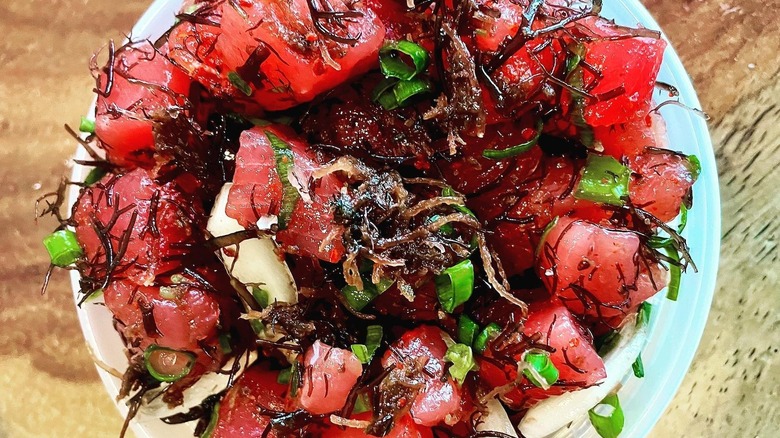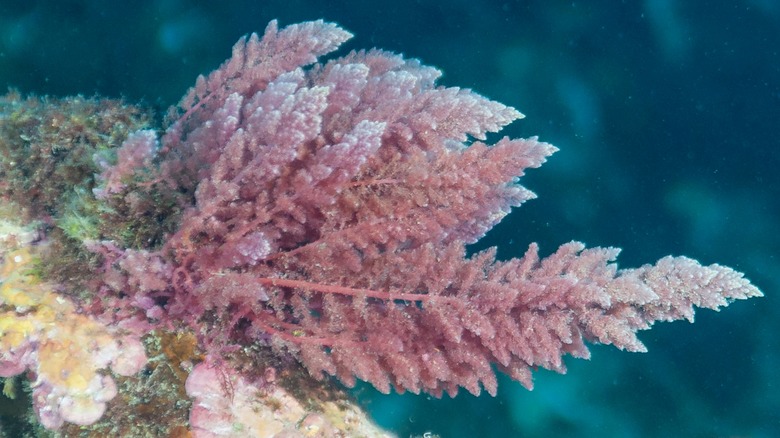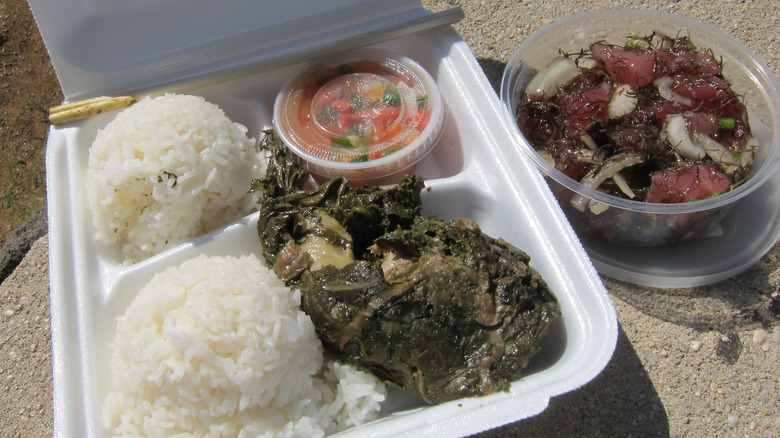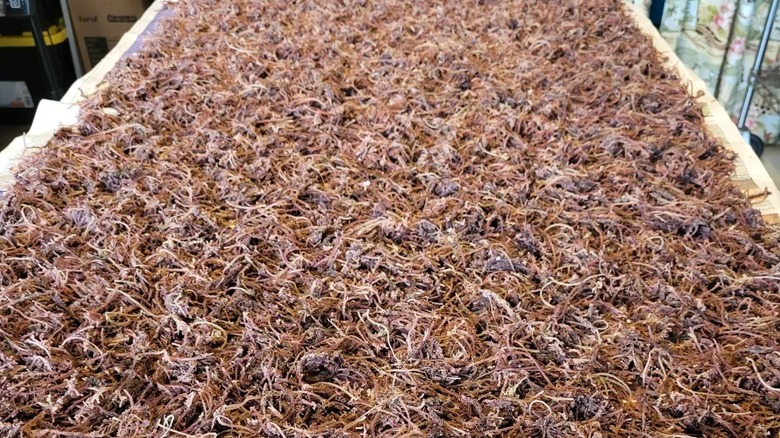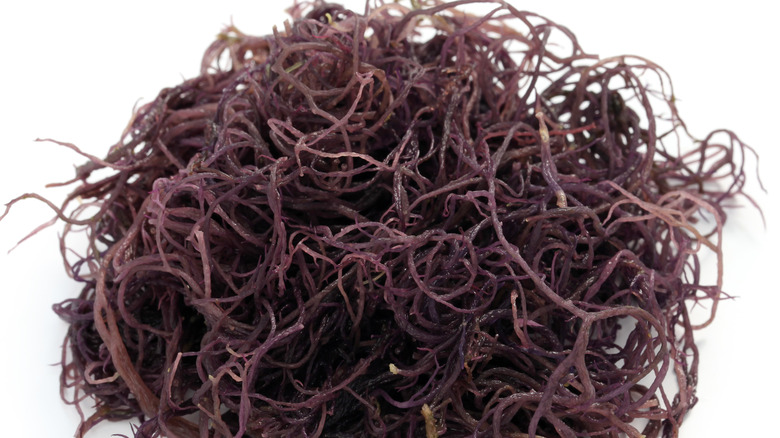Limu Kohu Is The Special Ingredient That Needs A Place In Your Poke Bowls
Picture edible seaweed and Asian foods like nori and wakame probably spring to mind. However, the practice of consuming aquatic plants extends to many other regions, too — seaweed has been historically foraged in Nordic nations, as well as coastal parts of North and South America. And with its geographic location surrounded by ocean, it may come as no surprise that Polynesian cultures also use these plants in their cooking.
Seaweed is especially popular in Hawaii — where it's called limu. Although many types exist, none is more popular and well-regarded than limu kohu (Asparagopsis taxiformis). This attractive reddish-white aquatic plant delivers a pungent flavor, which pairs especially well with raw fish. As a result, it's an iconic ingredient in Hawaii's beloved poke bowls. As well as being delicious, the seaweed evinces a culinary tradition nearly erased over the last centuries. Limu kohu is not often found outside of Hawaii, which makes it an especially important ingredient to the islands' heritage. We consulted scientific reports, historic documents, and other written cultural sources to provide a comprehensive overview of the seaweed. So let's dive into what this special limu kohu ingredient is all about.
What is limu kohu?
Limu kohu is one of several seaweed species consumed in Hawaii. The archipelago stands out in its abundant consumption of marine plants, even amongst other Polynesian cultures. Especially prior to foreign contact, seaweed — limu — provided vital nourishment and flavor. It also comprised important cultural roles and was frequently traded. Research by marine scientists at the University of Hawaii found that at one point, at least 70 species of seaweed were consumed, however, this number has drastically shrunk in recent times.
The reddish-white plant grows at shallow depths of less than four feet in areas with many waves. Past the base, it has soft and furry growths resembling small pine cones. Whenever foraged, only the top sections are harvested. Then, some spores are shaken onto the reef to ensure that limu kohu's proliferation continues. A lack of awareness regarding the plant has threatened its population, although new approaches to sustainability have continued its harvest for eating.
How to cook with limu kohu
Limu kohu has a bold taste, best described as bitter and iodine-like, with oceanic notes. To minimize some of its pungency, it's put through several processes before use in the kitchen. First, the seaweed is thoroughly rinsed in freshwater to avoid any off-putting flavors. Next, it is soaked overnight in freshwater before being salted. At this stage, the raw limu kohu is ready for use, and can be enjoyed in salads. However, it is more frequently pounded, dried, and tightly rolled to increase shelf stability.
Most notably, limu kohu is used as a traditional flavoring in poke bowls, with its qualities aligning with raw fish. It's simply chopped alongside other ingredients that include chili, ginger, onion, garlic, and roasted nuts, and chilled. The seaweed is also frequently used to season beef, used to flavor raw liver, and as an ingredient in meat stews. The plant can also be consumed in salads, melding well with Asian flavors such as ginger, shoyu, and soy sauce. It's a seaweed that will always deliver a flavorful punch.
How to buy and store limu kohu
Unfortunately, limu kohu is becoming harder to purchase, even in Hawaii. In the archipelago, it is most typically sold in local markets, although in some areas, it may be available in the supermarket. Fresh versions of the seaweed have nearly disappeared altogether; it's typically only sold in its dried form. It's also worth searching for the seaweed online. Limu kohu can also be bought as an infused sauce at Sauced Kauai.
Limu kohu is more durable than other seaweed types. It can be stored for several weeks when not refrigerated, but colder conditions will make it last nearly indefinitely. Note that salted variants of limu kohu will be edible for even longer. While the aquatic plant takes some effort to procure, the search is worthwhile; it creates a traditional Hawaiian version of poke with a unique flavor. Since it only necessitates a small amount and keeps well, there's no pressure to utilize the bulk of a purchase quickly. So, if you can, buy a batch to experience a Hawaiian flavor unlike anything else. And if all else fails, it's time to book a vacation to the islands to taste the unique ingredient there.
Nutritional information about limu kohu
Although there hasn't been extensive scientific research conducted regarding limu kohu, the seaweed has shown some nutritional benefits. A study published in the Journal of Applied Phycology states that it's a noted source of protein, with around 10% of its weight comprised of the nourishing compound. Protein is essential to health, regulating physical processes, enabling biochemical reactions, and providing energy notes Healthline. It's no surprise that the seaweed was historically an important source of nourishment on the islands.
Additionally, limu kohu contains concentrations of Vitamins A, which regulates organ processes, enhances vision, and offers immune support, reports the National Institutes of Health. The seaweed also offers a dose of riboflavin, which is good for reducing inflammation — especially helpful against migraines, per Harvard School of Public Health. And like some fruits and vegetables, limu kohu also offers a dose of Vitamin C. So, although typically consumed amounts of limu kohu may be on the smaller side, the food does pack in some helpful health benefits.
